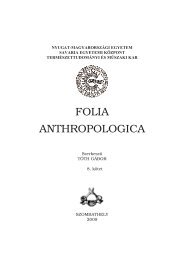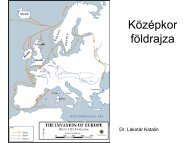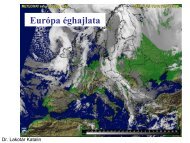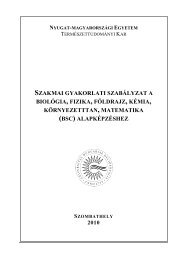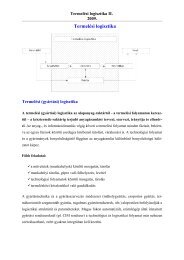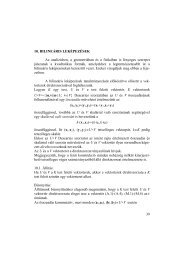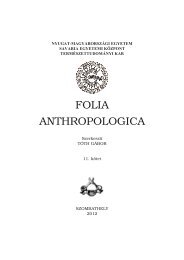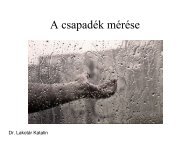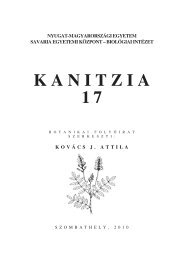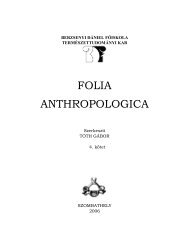Kanitzia 18. - NYME Természettudományi Kar - Nyugat ...
Kanitzia 18. - NYME Természettudományi Kar - Nyugat ...
Kanitzia 18. - NYME Természettudományi Kar - Nyugat ...
Create successful ePaper yourself
Turn your PDF publications into a flip-book with our unique Google optimized e-Paper software.
K A N I T Z I A <strong>Kanitzia</strong> 18: 59–88., Szombathely, 2011<br />
Journal of Botany<br />
VEGETATION ECOLOGY AND COENOLOGICAL RELATIONS<br />
OF KRASCHENINNIKOVIA CERATOIDES IN THE TRANSYLVANIAN BASIN<br />
KOVÁCS J. ATTILA<br />
Institute of Biology, University of West Hungary,<br />
9701-Szombathely, POBox 170, Hungary, kja@ttk.nyme.hu<br />
Abstract<br />
KOVÁCS J. A. (2011): Vegetation ecology and coenological relations of Krascheninnikovia ceratoides<br />
stands in the Transylvanian Basin. – <strong>Kanitzia</strong> 18: 59–88.<br />
Coenological and ecological studies on the steppic and dry grasslands in Transylvania demonstrated<br />
the presence and distribution in new sites of the irano-turanian-pontic steppe element Krascheninnikovia<br />
ceratoides, which abased on the disjunct area and isolated population-stands in Europe is<br />
considered as a relict of the cold dry climate of the periglacial landscape. Field investigation on vegetation<br />
ecology and coenological relations of all actually known sites in the Transylvanian Basin (near<br />
Vultureni, Groapa Rădăii, Poiana Frăţii, Pănet) showed that this drought resistant species is well<br />
adapted to the arid niches, open dry sites, abrupt reliefs, ancient landslides, to the warming up-drying<br />
up processes inducing subdesert-like microclimate and local steppe conditions on sand, clay and marl<br />
substrates. The favourable biological and ecological features of this species explain his historical<br />
succes to colonize altered habitats and contribute to preserve particular coenotic stands.<br />
As a results of the coenological analysis a new plant community, the Agropyro cristati-<br />
Krascheninnikovietum ceratoidis ass. nova (Table 1, Typus relevé 7), was described, with continental<br />
and pontic characteristics, given by the dominant stands (K. ceratoides) and the xerothermic diagnostic<br />
species groups (Krascheninnikovia ceratoides, Agropyrum cristatum, Artemisia campestris<br />
agg., Artemisia austriaca, Artemisia pontica, Brassica elongata, Astragalus monspessulanus) which<br />
indicate transitional characteristics between the Artemisio-Kochion and Festucion rupicolae alliances.<br />
The new community has close coenotic and ecologic relationships with the Artemisietum ponticocampestris<br />
(Transylvanian Basin) and with the Agropyro cristati-Kochietum prostratae (Pannonian<br />
Basin). Stabilized coenotic stands of K. ceratoides were reported from other disturbed dry glasslands<br />
(Bothriochloetum ischaemi, Potentillo arenariae-Stipetum capillatae) also. Small and rare populations<br />
of K. ceratoides can be found in other steppic meadows and eroded dry grasslands (Stipetum<br />
pulcherrimae, Stipetum lessingianae, Cariceto humilis-Festucetum rupicolae, Artemisietum ponticocampestris,<br />
Artemisietum campestris-Agropyretum intermedii).<br />
It can be concluded that the species K. ceratoides with a large biological adaptability presents<br />
a great resistency to the continuous natural landslide processes, site erosion and fragmentation,<br />
but supports less the annually vegetation burning, the intensive grazing pressure, clearings, strong<br />
afforestations, different agricultural and economic interventions. Nevertheless, this species surviving<br />
in the presented habitats and plant communities investigated must be considered as vulnerable, so<br />
for these particular steppic vegetation, as relic enclave of the Holocene vegetation history, it would<br />
be necessary to apply a saving and protection regime using the ’European priority habitats’ and also<br />
the Transylvanian IPA-system.<br />
59




